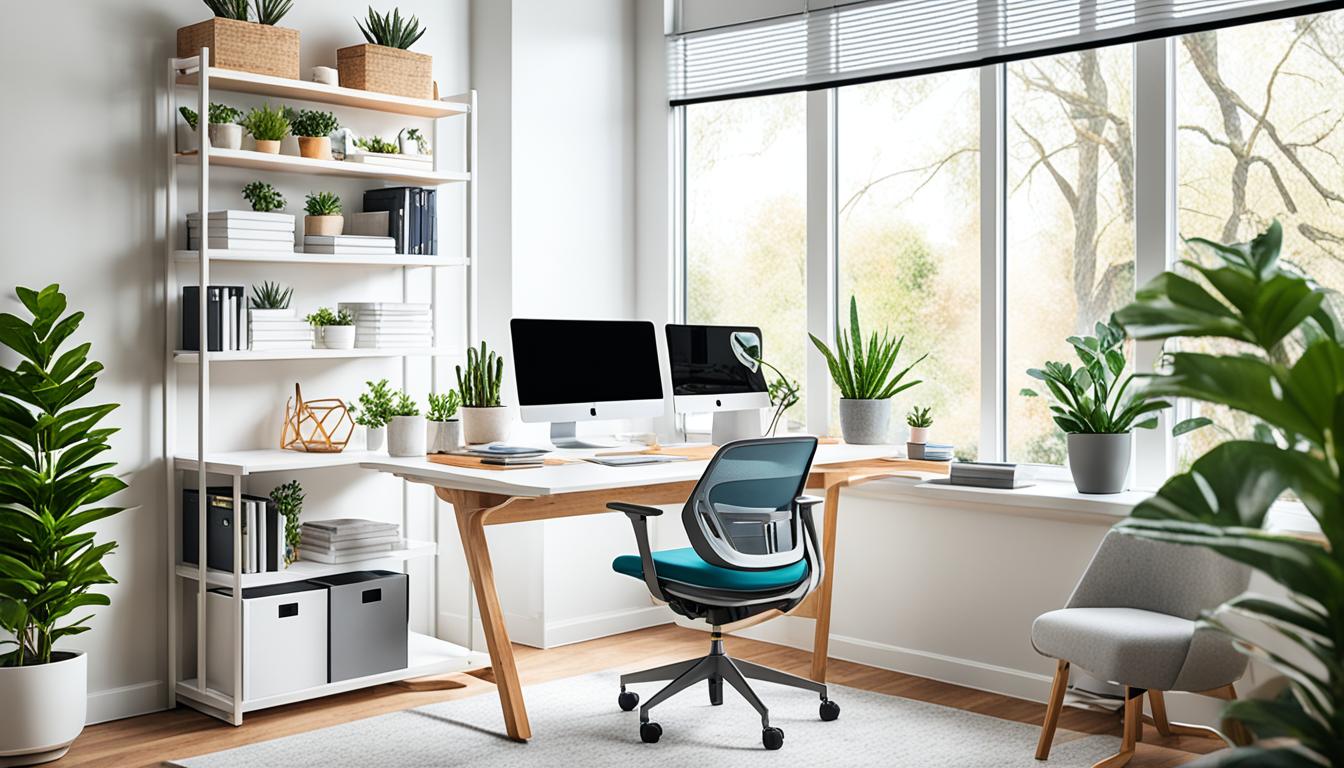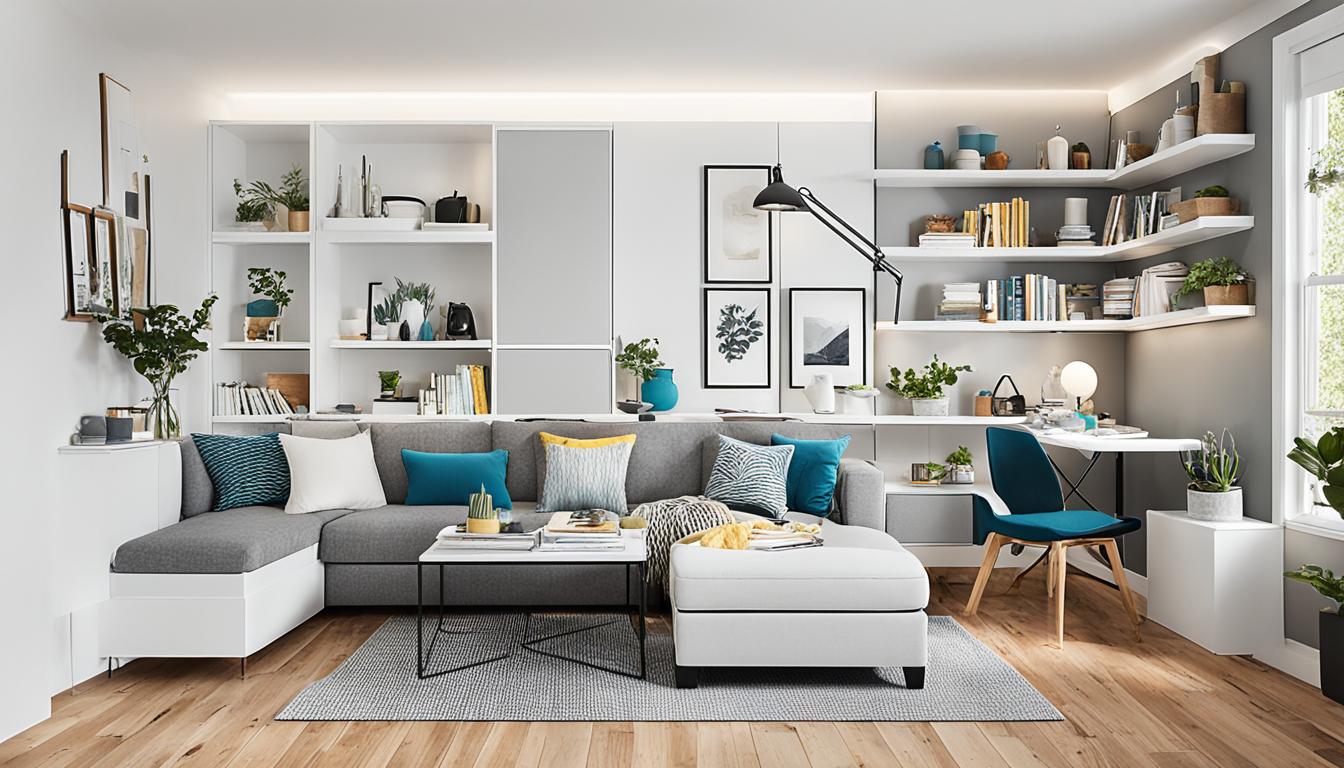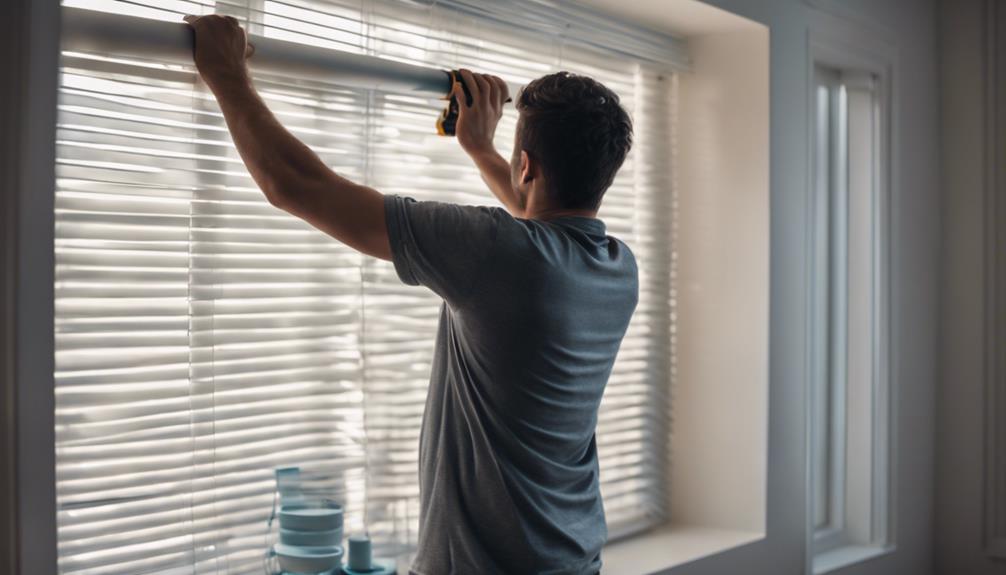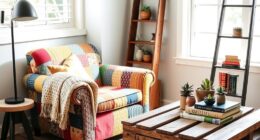As the workplace evolves rapidly, more individuals are transforming their living spaces into home offices. Picture someone who previously commuted to work now telecommuting due to the pandemic. They have taken steps to enhance and create a more comfortable workspace.
They made big changes: a new ergonomic chair, a bigger desk, and organized cabinets. These changes made them 13% more productive and happier at work. This story shows how a good home office setup can really make a difference. It encourages others to create a space that boosts both creativity and work efficiency.
Key Takeaways
- The right home office setup can increase productivity by 13% or more.
- Ergonomic chairs prevent distractions and encourage better work habits.
- Natural light greatly enhances mental health and productivity.
- Quality lighting can reduce eye strain and improve work focus.
- Organized workspaces contribute to enhanced creativity and efficiency.
- Incorporating plants into the workspace can stimulate innovation.
- Using reliable technology and tools is crucial for long-term remote work success.
The Importance of a Productive Home Office
Creating a productive home office is vital for remote workers. Currently, 55% of workers choose a hybrid work model, craving more flexibility. This trend stresses the productivity importance of having a dedicated workspace. It helps improve focus and efficiency.
About 80% of company leaders now see that their teams will work remotely at least one day weekly post-pandemic. This shift makes it crucial to make home offices better for mental health and job happiness.
An effective workspace means fewer distractions. Multi-use areas usually bring challenges, lowering focus. Picking a spot just for work helps increase productivity.
Ergonomics also matter in a home office. Choosing the right furniture, like adjustable chairs and desks, helps avoid pains. Research shows that ergonomic setups boost productivity and wellness.
Natural light is key for productivity too. It’s proven that daylight improves mood, reduces eye strain, and keeps you alert. A bright, inviting workspace leads to better work and satisfaction. With the right setup, your home office supports both your job and your well-being.
Understanding Your Work Environment
Optimizing a home office means understanding its unique challenges. Identifying distractions is the first step to increasing productivity. Nosie, chores, or TV can interrupt your work.
Recognizing these helps you set boundaries. This is key to creating an effective office space at home.
Identifying Distractions at Home
Addressing these challenges needs open talk with family or roommates. Noise from them or pets can break focus. Noise-cancelling headphones can help reduce this noise.
Setting a work schedule and sharing it with others helps. This makes your work time respected.
Creating a Workspace Setup
Where you work really affects your productivity. Choosing a quiet spot away from daily life reduces interruptions. Your workspace should be comfy, with furniture that supports your posture.
Make sure things you use a lot are easy to reach. Adding things like art or plants can make the space nicer. Studies show plants in the workspace can make you react 12% faster.
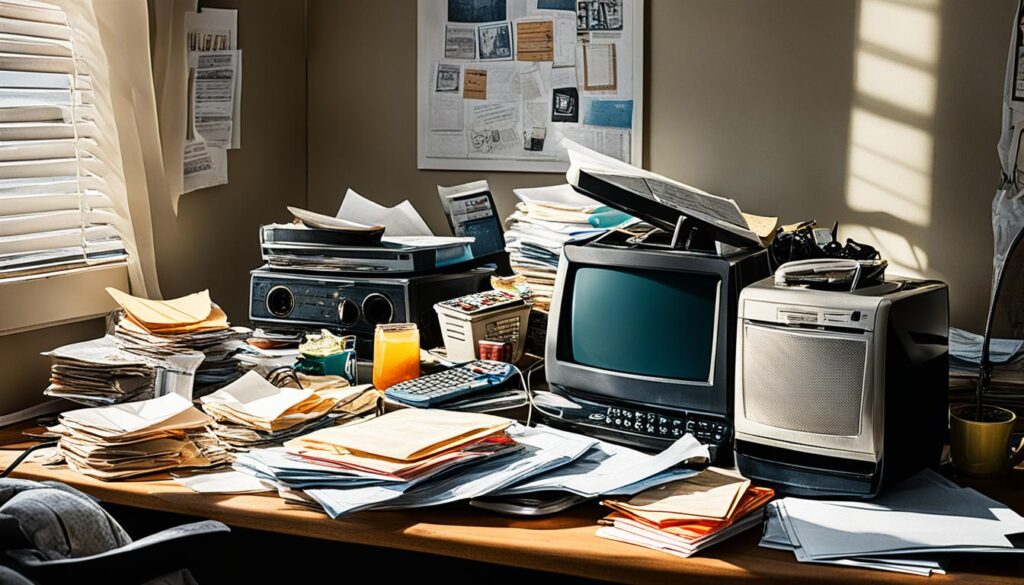
Creating a Home Office That Boosts Productivity and Well-being
A great home office boosts work and comfort. Having a good workspace can make you 30% more productive and more creative. Also, using ergonomic furniture reduces health issues by 40%, which is key for comfort at work.
Natural light is very important in a home office. It can lessen eyestrain by 60%, letting you work longer without discomfort. Also, keeping your space tidy helps with creativity and efficiency. Less clutter means fewer distractions.
Personalizing your office boosts creativity by up to 25%. Adding things like vision boards or motivational quotes can make a big difference. Spaces that feel personal inspire more innovation than plain ones.
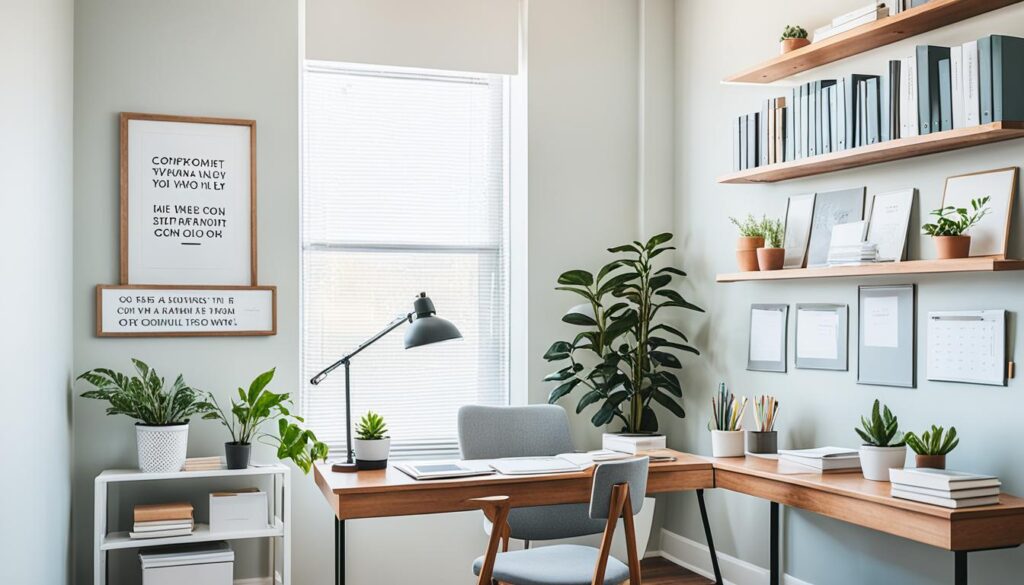
Good lighting and flexible work hours also help a lot. They can improve your focus and keep you less tired. Plus, having separate spaces can help you concentrate better than in open-concept areas.
In short, creating the right home office is very important. You need a place that looks good and works well. This way, you can be more productive and feel better while working.
Ergonomics: The Key to Comfort
Making your workspace ergonomic is key to feeling comfy and being more productive. The shift to working from home has made us see how important ergonomics is. By trying to reduce how much we strain ourselves, many have learned how valuable good office furniture can be.
Choosing an Ergonomic Chair and Desk
An ergonomic chair is important for keeping your posture right and reducing discomfort during long hours of work. Buying high-quality chairs like the Paxton, Hull, or Webb can really make a difference. These chairs support your lower back and can be adjusted to fit what you like. Desk ergonomics is also important. A desk that lets you sit or stand, like the Lopp or Wolfe Smart, helps you move and not get sore.
Proper Monitor and Keyboard Placement
Where your monitor and keyboard sit is crucial for a good workstation. Your monitor should be at eye level to avoid neck pain and be easy on your eyes. It should be about an arm’s length away, so you can sit comfortably. Your keyboard should be positioned in a way that keeps your shoulders relaxed. Your wrists should be straight and hands slightly lower than your elbows. Making these changes can really help you stay comfy and work better when you’re on the computer for a long time.
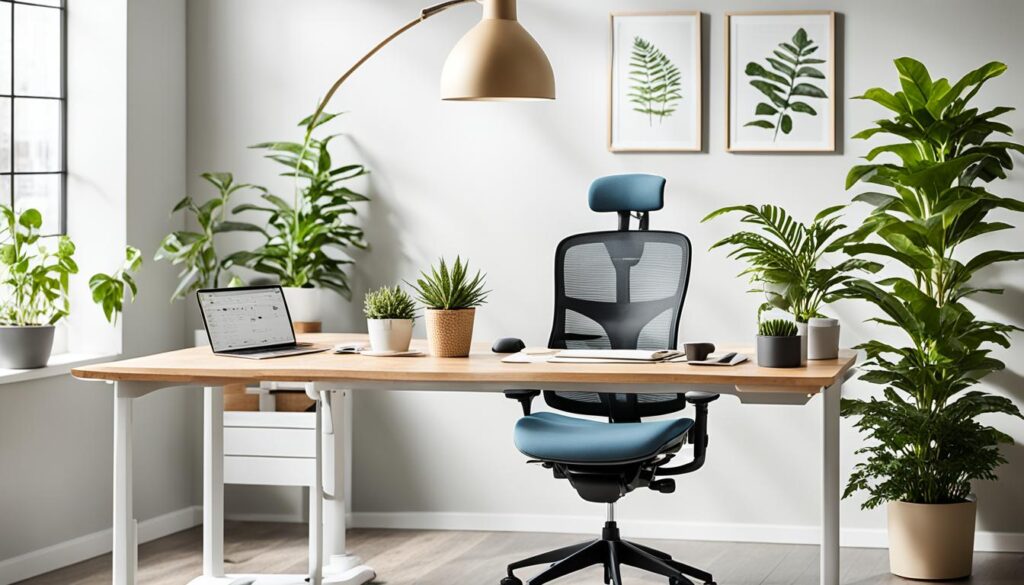
| Furniture Type | Key Features | Benefits |
|---|---|---|
| Ergonomic Chair | Adjustable height, lumbar support, comfortable cushioning | Improved posture, reduced strain, increased comfort |
| Sit-Stand Desk | Height-adjustable, stable surface, ample space | Reduces physical strain, boosts energy levels, enhances focus |
| Monitor Stand | Adjustable height, stable design | Maintains eye level, reduces neck strain |
| Ergonomic Keyboard | Split design, wrist support, adjustable angle | Promotes relaxed shoulder position, reduces wrist strain |
Lighting: Setting the Right Mood
Effective lighting is key in a home office. It shapes productivity and well-being. Using natural light is vital. It greatly improves the work space. The right lighting fixtures add to this, balancing comfort and energy efficiency.
The Benefits of Natural Light
Natural light boosts any workspace. It improves mood, focus, and productivity. Sunlight regulates melatonin, enhancing energy and focus. Place desks by windows for more sunlight. Taking breaks outside also helps with fresh air and sun.
Using Ambient and Task Lighting
Ambient and task lighting are important too. Ambient lighting sets the mood. Task lighting focuses light on specific areas, like desks. Mixing both types is best for a good workspace. Examples include:
- LED desk lamps like the AERTIA CERAMIC Table Lamp. They give bright light and save electricity by 89%.
- Dimmable ANON LED Light Bulbs. They add beauty and save energy.
- Smart lighting systems for control with apps or voice. They offer convenience and save power.
Putting these lights in the right spots reduces glare and shadows. It also prevents eye strain from screens. Plus, adjusting lighting for the workspace size and work type makes an atmosphere that helps work feel better.
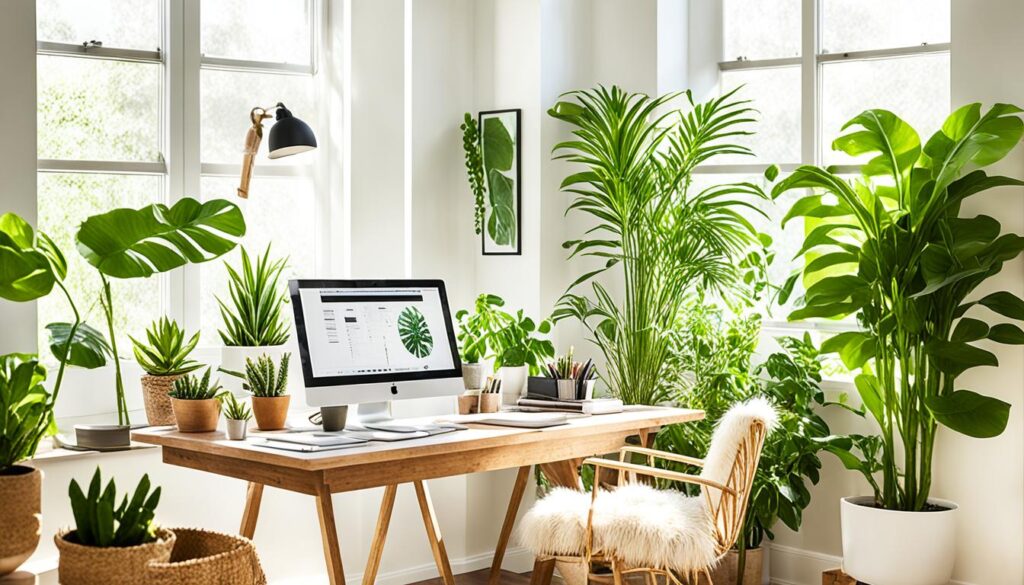
| Lighting Type | Features | Benefits |
|---|---|---|
| Natural Light | Direct sunlight from windows | Boosts mood, enhances focus, regulates circadian rhythms |
| Ambient Lighting | Overhead lighting, ceiling fixtures | Sets the mood, provides overall illumination |
| Task Lighting | Desk lamps, adjustable LED lights | Highlights specific work areas, reduces eye strain |
Mixing lighting types improves home office lighting. It makes working from home more comfortable and productive.
Investing in Quality Technology
Remote work has changed how we set up our home offices. Quality tech is key for a productive space. It includes reliable computers, stable internet, and good webcams for online meetings.
Adding productivity tools boosts your work experience too. For example, an extra monitor helps with multitasking. An ergonomic keyboard eases typing strain, and noise-cancelling headphones block out distractions.
Don’t forget about comfy furniture. A chair with good lumbar support can prevent back pain. This, combined with the right tech, keeps you productive all day.
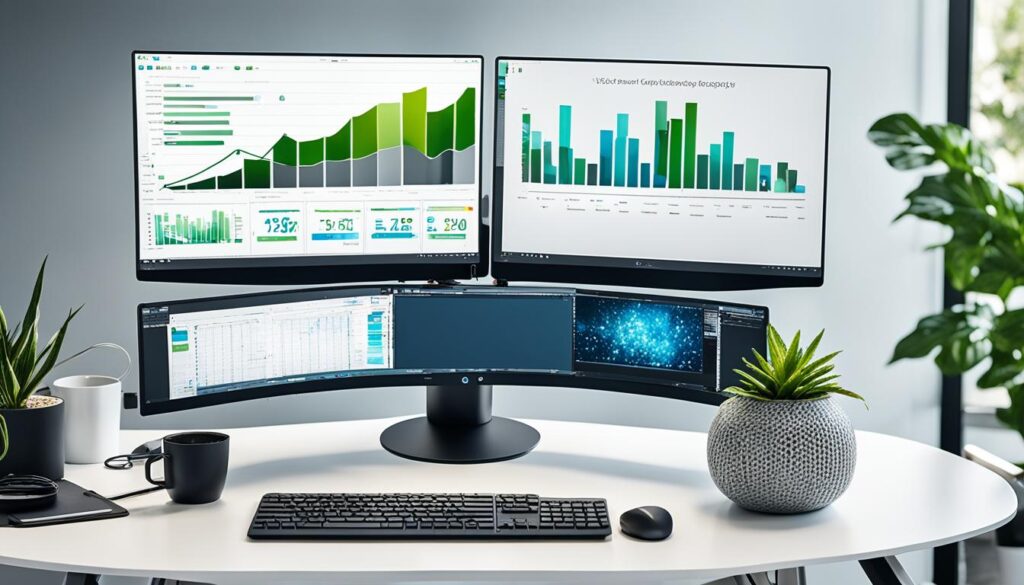
Minimizing Distractions in Your Home Office
A well-organized workspace boosts productivity in a home office. It’s key to have effective organization strategies. Decluttering helps by removing distractions that hurt focus, keeping your mind clear.
Organizing Your Workspace
Using things like file cabinets and desktop organizers makes a big difference. They ensure everything has its place, saving you time. A neat workspace also feels more professional and ready for work.
Using Noise-Cancelling Headphones
Noise can make it hard to concentrate, especially in busy places. Quality noise-cancelling headphones help. They’re great for clear audio in meetings and for creating a focused environment. This makes them a must-have for boosting productivity.
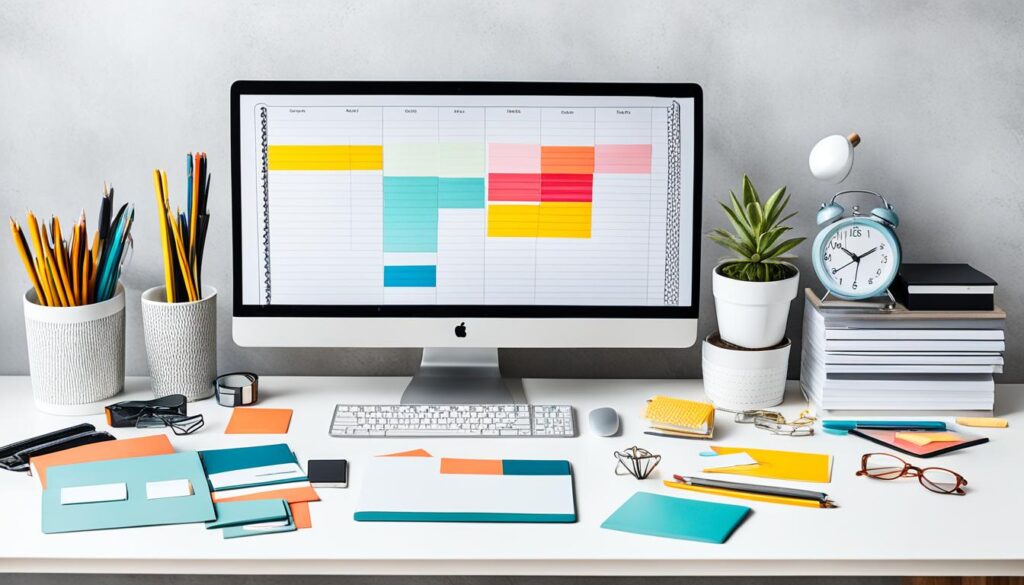
Personalizing Your Office Space
Creating a personal office space boosts motivation and enhances well-being. Adding decor and personal touches makes the space more appealing and creates a connection. Simple changes can make your workspace inspiring, increasing productivity and improving mood.
Incorporating Personal Touches
Adding personal items to your office can make it reflect your personality. Photos, artwork, and quotes can make you feel good and energize the space. Studies show that custom workspaces can make you 36% more productive, proving the value of personal touches.
Decor Ideas to Inspire You
Colors are key in setting the vibe of your office. Blue hues bring calm and focus. Yellow inspires creativity, and green is soothing and good for your eyes. Plants add a touch of nature, cut stress by 15%, and make the air healthier. Designing different areas for specific tasks can also help you concentrate better. A cozy corner for reading with comfy seats and nice light can boost happiness by 46%. Special stationery and supplies can increase your satisfaction by 27%. Here’s a quick look at some decor ideas:
| Decor Element | Benefit |
|---|---|
| Personal Photos | Enhances emotional connection |
| Artwork | Boosts creativity and mood |
| Vision Boards | Increases goal achievement by 50% |
| Plants | Improves air quality and reduces stress |
| Comfortable Seating | Boosts morale and encourages breaks |
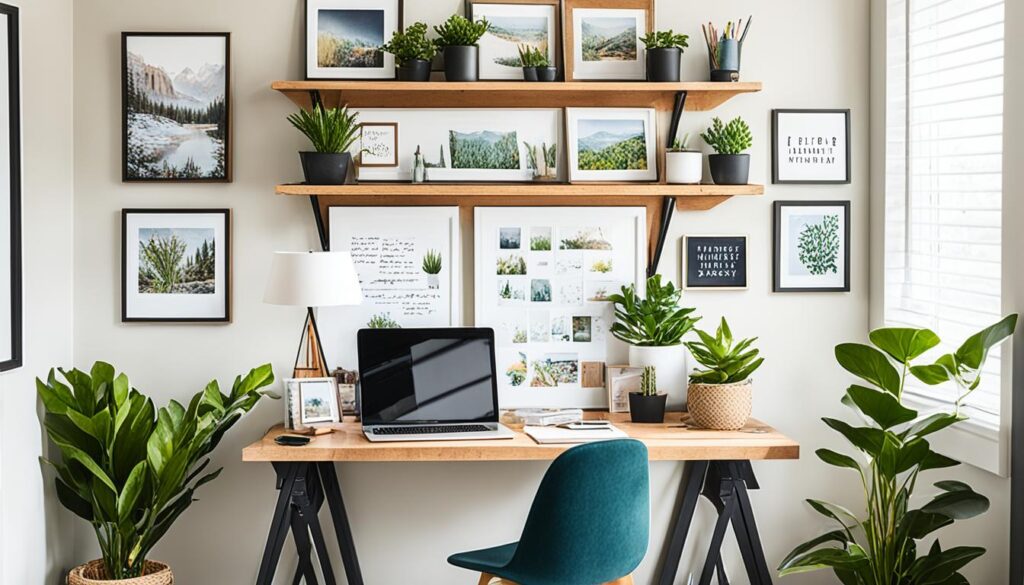
With careful thought, you can turn your home office into a space that sparks creativity and boosts productivity and well-being.
Maintaining Work-Life Balance
Finding the right work-life balance is tough, more so with remote work’s rise. About 60% of U.S. workers feel their work-life balance isn’t good enough. Working from home has made it hard to separate work from personal life, making it important to set boundaries.
Before the pandemic, around 20% of people worked remotely. This number jumped to almost 70% during the pandemic. Homes turned into spaces for work, school, play, and exercise. It’s hard to tell work from free time, leading to burnout. Overworking can make you less motivated and productive, trapping you in a difficult cycle.
Starting small habits, like organizing tasks or using time management strategies such as the Pomodoro Technique, helps. It’s also crucial to set achievable goals to keep up motivation. Taking regular breaks is important for staying productive all day.
Setting clear work and personal time boundaries increases focus and creativity. Task delegation helps lessen stress and prevents burnout. Studies show that having a dedicated work area boosts productivity and happiness at work.
To sum up, here are some key ways to keep a good work-life balance with remote work:
| Practice | Description |
|---|---|
| Set Work Hours | Define clear start and end times for your workday to create separation. |
| Taking Breaks | Implement regular intervals for rest to maintain focus and energy levels. |
| Designate a Workspace | Create a specific area for work to mentally transition between home and work modes. |
| Prioritize Tasks | Identify and tackle essential tasks first, minimizing feelings of overwhelm. |
| Use Technology Wisely | Employ tools that help streamline tasks while avoiding distractions. |
| Delegate Responsibilities | Share workloads with team members to lighten personal stress. |
| Regular Check-Ins | Meet with colleagues to reflect on workloads and provide support. |
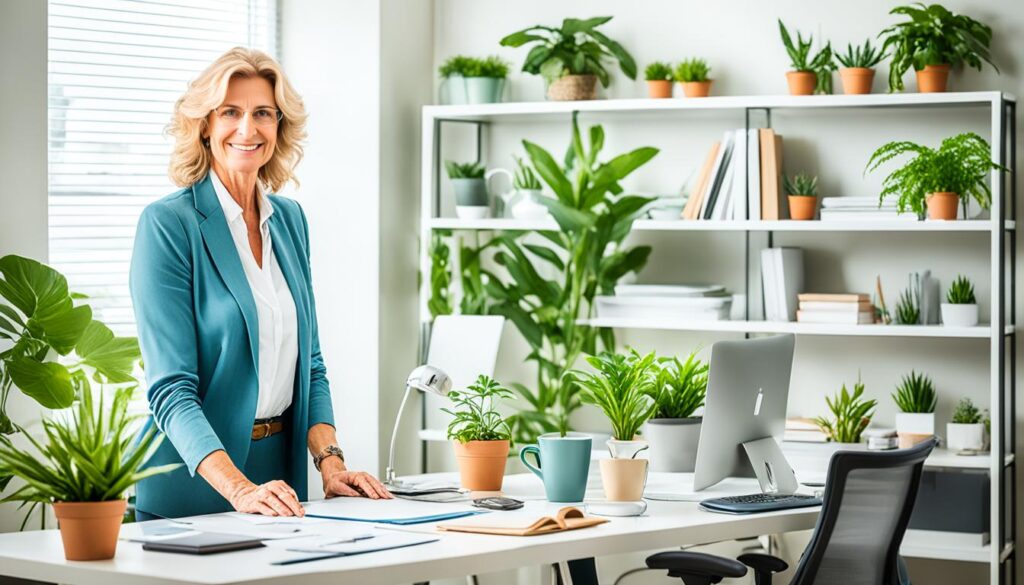
Adding Elements of Nature
Bringing nature into home offices can make them calm and efficient places. Most people living in cities stay indoors for up to 90% of their day. So, having indoor plants is crucial for a better work area. Studies show plants can make the air cleaner, which is important for feeling fresh.
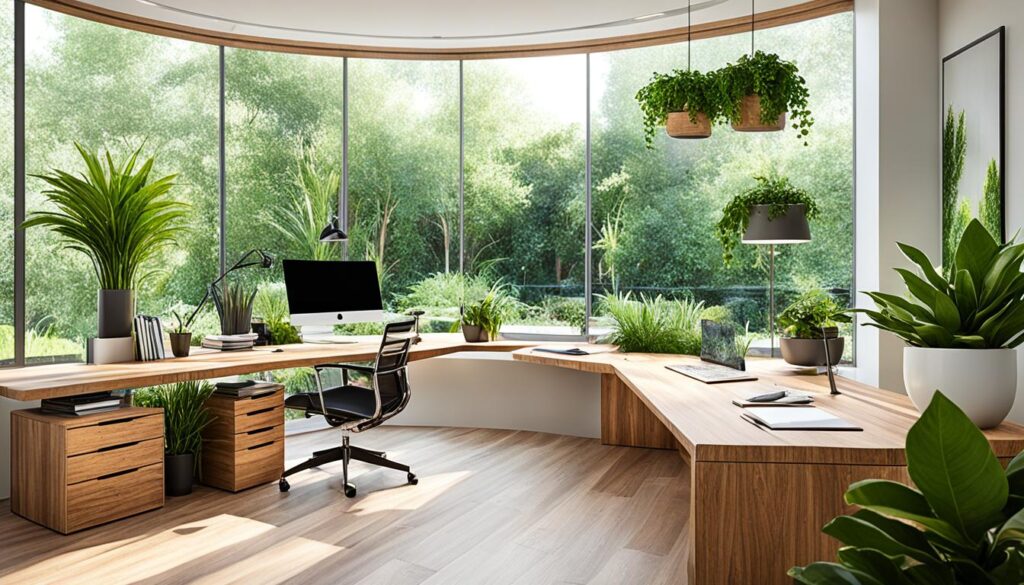
Indoor plants do more than just make a space look good. They can help improve memory by 20%. Adding greenery helps reduce stress and anxiety by 37%, depression by 58%, and anger by 44%. Research proves that people in offices with plants think 26% better. They also get sick less, cutting down absence by 30%.
Natural light is something 44% of employees want more of in their work area. It boosts mood and energy, making people feel better. Some plants like the Snake, Spider, and Peace Lily clean the air and don’t need much care. They are great for office spaces.
- Indoor plants contribute to a lively atmosphere.
- Natural materials like wood and bamboo create warmth and connection to the outdoors.
- Employees report lower stress levels and enhanced creativity in plant-filled spaces.
Connecting with nature in home offices leads to a healthy, welcoming, and efficient workspace. The beauty of nature, along with its benefits for health and work, shows its importance in today’s offices.
Smart Storage Solutions for Your Home Office
Having an organized workspace at home is vital. Smart storage solutions keep your office efficient and free from clutter. They also use vertical space well. This helps make your office organized while keeping it welcoming.
Utilizing Vertical Space
Vertical storage boosts space use in your office. Here are some ideas:
- Install shelves above desks to store books, files, and decorative elements.
- Use wall-mounted organizers for easy access to office supplies like pens and notepads.
- Utilize high shelves to keep rarely used items out of sight.
These ideas help you keep organized and also make space for creativity and comfort. Getting rid of old papers regularly also helps keep storage neat.
Essential Office Supplies to Keep Organized
The right office supplies improve efficiency. Keeping stock ensures you always have necessary items. Here are key supplies for an organized office:
| Essential Supplies | Purpose |
|---|---|
| Notebooks | For taking notes and tracking tasks. |
| Sticky Notes | For reminders and quick reference. |
| Pens and Markers | Essential for writing and highlighting information. |
| File Folders | Keeps documents categorized and easily accessible. |
Sorting your office supplies boosts productivity and streamlines your work area. Setting aside four hours to organize can offer long-term focus benefits.
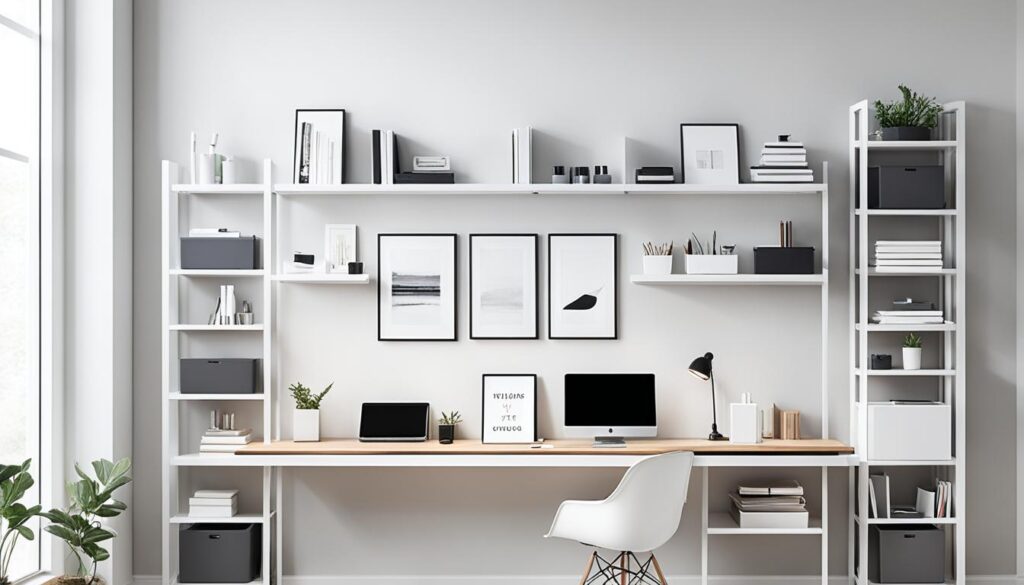
Conclusion
Creating an effective home office is crucial for productivity and well-being. Ergonomic furniture, natural light, and a clean space are key. These factors help increase focus, reduce pain, and make a positive work environment.
Setting work hours and using tools to manage tasks help too. Good air quality and taking breaks are important for your mind and body. Adding plants can boost your mood and health. Making these changes can create a home office that improves work and happiness.
As more people work from home, the design of a home office matters a lot. It affects how well we work and feel. Focusing on a supportive space is essential for success in work and life.
